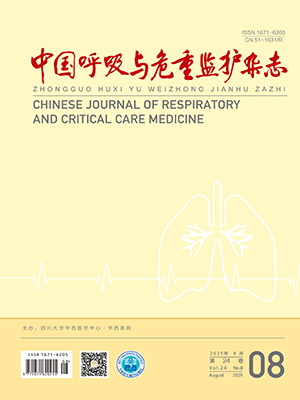| 1. |
Bellani G, Laffey JG, Pham T, et al. Epidemiology, patterns of care, and mortality for patients with acute respiratory distress syndrome in intensive care units in 50 countries. JAMA, 2016, 315(8): 788-800.
|
| 2. |
王桥生, 王美求, 符晖. 脓毒症相关急性呼吸窘迫综合征短期死亡风险评分标准构建. 中国呼吸与危重监护杂志, 2022, 21(3): 162-169.
|
| 3. |
Sahetya SK, Goligher EC, Brower RG. Fifty years of research in ARDS. Setting positive end-expiratory pressure in acute respiratory distress syndrome. Am J Respir Crit Care Med, 2017, 195(11): 1429-1438.
|
| 4. |
Adler A, Amato MB, Arnold JH, et al. Whither lung EIT: where are we, where do we want to go and what do we need to get there?. Physiol Meas, 2012, 33(5): 679-694.
|
| 5. |
Caironi P, Cressoni M, Chiumello D, et al. Lung opening and closing during ventilation of acute respiratory distress syndrome. Am J Respir Crit Care Med, 2010, 181(6): 578-586.
|
| 6. |
中国卫生信息与健康医疗大数据学会重症医学分会标准委员会, 北京肿瘤学会重症医学专业委员会, 中国重症肺电阻抗工作组. 肺电阻抗成像技术在重症呼吸管理中的临床应用中国专家共识. 中华医学杂志, 2022, 2(9): 615-628.
|
| 7. |
The ARDS Definition Task Force, Ranieri VM, Rubenfeld GD, et al. Acute respiratory distress syndrome: the Berlin Definition. JAMA, 2012, 307(23): 2526-2533.
|
| 8. |
The Acute Respiratory Distress Syndrome Network, Brower RG, Matthay MA, et al. Ventilation with lower tidal volumes as compared with traditional tidal volumes for acute lung injury and the acute respiratory distress syndrome. N Engl J Med, 2000, 342(18): 1301-1308.
|
| 9. |
李莲花, 杨倩, 李黎明, 等. 肺部超声评分评估急性呼吸窘迫综合征患者病情严重程度及预后的价值. 中华危重病急救医学, 2015, 27(7): 579-584.
|
| 10. |
Bouhemad B, Brisson H, Le-Guen M, et al. Bedside ultrasound assessment of positive end-xpiratory pressure-induced lung recruitment. Am J Respir Crit Care Med, 2011, 183(3): 341-347.
|
| 11. |
张斌, 吴秀, 曹薇, 等. 肺部超声评分在呼吸重症疾病中的应用. 中国呼吸与危重监护杂志, 2019, 18(1): 93-97.
|
| 12. |
Bouhemad B, Liu ZH, Arbelot C, et al. Ultrasound assessment of antibiotic-induced pulmonary reaeration in ventilator-associated pneumonia. Crit Care Med, 2010, 38(1): 84-92.
|
| 13. |
Ashbaugh DG, Bigelow DB, Petty TL, et al. Acute respiratory distress in adults. Lancet, 1967, 290(7511): 319-323.
|
| 14. |
郭俊, 徐景龙. PEEP水平选择对俯卧位通气重度ARDS患者肺复张效果和炎性因子的影响. 中华危重病急救医学, 2020, 32(6): 702-706.
|
| 15. |
陈宇, 罗春梅, 贺斌峰, 等. 不同水平PEEP治疗对ICU非ALI/ARDS患者ARDS发生率影响的Meta分析. 中华危重病急救医学, 2020, 32(2): 155-160.
|
| 16. |
王金龙, 黄英姿. 驱动压在急性呼吸窘迫综合征肺保护性通气中的研究进展. 中华内科杂志, 2018, 57(10): 766-768.
|
| 17. |
Lachmann B. Open up the lung and keep the lung open. Intensive Care Med, 1992, 18(6): 319-321.
|
| 18. |
Kalchiem-Dekel O, Shanholtz CB, Jeudy J, et al. Feasibility, safety, and utility of bronchoscopy in patients with ARDS while in the prone position. Crit Care, 2018, 22(1): 54.
|
| 19. |
Slutsky AS, Ranieri VM. Ventilator-induced lung injury. N Engl J Med, 2013, 369(22): 2126-2136.
|
| 20. |
王丽, 宋宁宁, 刘云, 等. 振动反应成像技术在ARDS患者PEEP设置中的应用. 国际呼吸杂志, 2019, 39(3): 210-214.
|
| 21. |
Zhao ZQ, Chang MY, Chang MY, et al. Positive end-expiratory pressure titration with electrical impedance tomography and pressure-volume curve in severe acute respiratory distress syndrome. Ann Intensive Care, 2019, 9(1): 7.
|
| 22. |
Sella N, Zarantonello F, Andreatta G, et al. Positive end-expiratory pressure titration in COVID-19 acute respiratory failure: electrical impedance tomography vs. PEEP/FiO2 tables. Crit Care, 2020, 24(1): 540.
|
| 23. |
van der Zee P, Somhorst P, Endeman H, et al. Electrical impedance tomography for positive end-expiratory pressure titration in COVID-19-related acute respiratory distress syndrome. Am J Respir Crit Care Med, 2020, 202(2): 280-284.
|
| 24. |
He HW, Chi Y, Yang YY, et al. Early individualized positive end-expiratory pressure guided by electrical impedance tomography in acute respiratory distress syndrome: a randomized controlled clinical trial. Crit Care, 2021, 25(1): 230.
|
| 25. |
Hsu HJ, Chang HT, Zhao ZQ, et al. Positive end-expiratory pressure titration with electrical impedance tomography and pressure-volume curve: a randomized trial in moderate to severe ARDS. Physiol Meas, 2021, 42(1): 014002.
|
| 26. |
汪晓强, 吴彤, 田婕. 超声诊断肺部疾病在重症医学中的应用. 医学综述, 2018, 24(23): 161-165.
|
| 27. |
Ma H, Huang DZ, Zhang MZ, et al. Lung ultrasound is a reliable method for evaluating extravascular lung water volume in rodents. BMC Anesthesiol, 2015, 15(1): 162.
|
| 28. |
罗前程, 刘瑞, 曲凯丽, 等. 床旁即时肺部超声结合压力–容积曲线设定PEEP对ARDS肺复张的临床评价. 宁夏医科大学学报, 2021, 43(1): 22-28.
|
| 29. |
田翠杰, 王海播, 张文平, 等. 电阻抗断层成像技术在呼吸系统疾病中的临床应用. 中国呼吸与危重监护杂志, 2020, 19(6): 617-620.
|
| 30. |
Perier F, Tuffet S, Maraffi T, et al. Electrical impedance tomography to titrate positive end-expiratory pressure in COVID-19 acute respiratory distress syndrome. Crit Care, 2020, 24(1): 678.
|
| 31. |
Puel F, Crognier L, Soulé C, et al. Assessment of electrical impedance tomography to set optimal positive end-expiratory pressure for veno-venous ECMO-treated severe ARDS patients. J Crit Care, 2020, 60: 38-44.
|
| 32. |
Becher T, Buchholz V, Hassel D, et al. Individualization of PEEP and tidal volume in ARDS patients with electrical impedance tomography: a pilot feasibility study. Ann Intensive Care, 2021, 11(1): 89.
|
| 33. |
Fan E, Brodie D, Slutsky AS. Acute respiratory distress syndrome: advances in diagnosis and treatment. JAMA, 2018, 319(7): 698-710.
|




